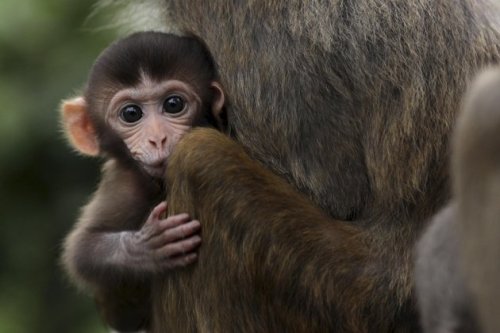US researchers said Thursday they have created the world's first mixed-embryo monkeys by merging cells from up to six different embryos, in what could be a big advance for medical research.

Until now, rodents have been the primary creatures used to make chimeras, a lab animal produced by combining two or more fertilized eggs or early embryos together.
Scientists have long been able to create "knock-out" mice with certain genes deleted in order to study a host of ailments and remedies, including obesity, heart disease, anxiety, diabetes and Parkinson's disease.
Attempts to create melded primates have failed in the past, but scientists in the western state of Oregon succeeded by altering the method used to make mice.
The breakthrough came when they mixed cells together from very early stage rhesus monkey embryos, in a state known as totipotent, when they are able to give rise to a whole animal as well as the placenta and other life-sustaining tissues.
"Knock-out" mice are typically made by introducing embryonic stem cells that have been cultured in a lab dish into a mouse embryo, but that method failed in monkeys.
Primate embryos do not allow cultured embryonic stem cells to become integrated, as mice do.
Combining primate cells apparently requires more potent, early stage cells from a living embryo, said lead researcher Shoukhrat Mitalipov of the Oregon National Primate Research Center at Oregon Health and Science University.
The experiment produced three healthy male rhesus monkeys they named Roku, Hex and Chimero, with gene traits from all of the separate embryos used to meld them.
"The cells never fuse, but they stay together and work together to form tissues and organs," said Mitalipov. "The possibilities for science are enormous."
The research is published online ahead of the release of the January 20 issue of the journal Cell.
Scientists use rhesus monkeys to study HIV/AIDS drugs, research vaccines for rabies, smallpox and polio, and to study potential uses for embryonic stem cells. They have also been launched into space on test missions by the US and Russia.
"We cannot model everything in the mouse," Mitalipov said. "If we want to move stem cell therapies from the lab to clinics and from the mouse to humans, we need to understand what these primate cells can and can't do."
Researchers at the same Oregon facility in 2000 created the first genetically modified monkey, ANDi, who was carrying an extra bit of DNA that was inserted while he was an unfertilized egg.
That experiment was described in Science in 2001. (AFP)
<한글 기사>
6개 게놈 섞인 키메라 원숭이 탄생
원숭이 6마리의 게놈이 섞여있는 사상최초의 키 메라 원숭이가 탄생했다.
미국 오리건 보건과학대학 국립영장류연구소(National Primate Research Center) 연구팀은 6마리의 원숭이 게놈이 섞여있는 키메라 원숭이 3마리를 탄생시켰다고 영국의 데일리 메일과 BBC인터넷판이 5일(현지시간) 보도했다.
키메라란 한 개체 속에 다른 개체의 세포가 섞여있는 생물을 말한다. 키메라는 명칭은 머리는 사자, 몸통은 산양, 꼬리는 용의 형상을 한 그리스 신화의 괴물 이름 에서 따온 것이다.
지금까지 과학자들이 키메라 쥐를 만들어낸 일은 있으나 영장류인 원숭이 키메 라가 만들어진 것은 이번이 처음으로 과학계에 적지 않은 파문과 윤리적 논란을 일 으킬 것으로 보인다.
슈크라트 미탈리포프(Shoukhrat Mitalipov) 박사가 이끄는 연구팀은 6마리의 짧 은꼬리원숭이 배아에서 추출한 세포들을 시험관에서 섞어 단일 배아로 만든 다음 대 리모 원숭이의 자궁에 착상시키는 방법으로 두 마리의 수컷 쌍둥이 '로쿠'(일본어로 6)와 '헥스'(그리스어로 6) 그리고 또 하나의 수컷 '키메로'를 탄생시켰다.
대부분의 포유동물은 두 부모의 유전물질이 섞인 세포를 가지고 있지만 이 키메 라 원숭이는 6마리의 생물학적 부모로부터 나온 서로 다른 DNA로 구성된 6가지 형태 의 세포를 지니고 있다.
세포들은 절대 융합하지 않지만 공동작업을 통해 조직과 장기를 형성할 수 있다 고 미탈리포프 박사는 설명했다.
원숭이는 지능이 높고 생물학적으로 인간과 가장 가까운 영장류이기 때문에 키 메라 원숭이의 탄생은 체외수정에서부터 인간장기의 제조에 이르기까지 과학계에 '
엄청난' 가능성을 열어 줄 것이라고 미탈리포프 박사는 말했다.
키메라는 특정 유전자들이 배아발달에서 어떤 역할을 하는지와 배아발달의 전반 적인 메커니즘을 이해하는 데 사용될 수 있다.
한편 동물보호단체들로부터는 이에 대한 비판이 쏟아져 나왔다.
영국생체학대방지연맹(BUAV)는 지각능력이 높은 동물을 과학연구에 이용하는 것 은 엄청난 윤리논란을 일으킬 것이라면서 만들어진 키메라 원숭이들은 앞으로 여러
가지 실험에 이용되면서 커다란 고통을 겪을 것이라고 비난했다.
이 연구결과는 과학전문지 '셀(Cell)' 온라인판에 발표되었다.
6개 게놈 섞인 키메라 원숭이 탄생
원숭이 6마리의 게놈이 섞여있는 사상최초의 키 메라 원숭이가 탄생했다.
미국 오리건 보건과학대학 국립영장류연구소(National Primate Research Center) 연구팀은 6마리의 원숭이 게놈이 섞여있는 키메라 원숭이 3마리를 탄생시켰다고 영국의 데일리 메일과 BBC인터넷판이 5일(현지시간) 보도했다.
키메라란 한 개체 속에 다른 개체의 세포가 섞여있는 생물을 말한다. 키메라는 명칭은 머리는 사자, 몸통은 산양, 꼬리는 용의 형상을 한 그리스 신화의 괴물 이름 에서 따온 것이다.
지금까지 과학자들이 키메라 쥐를 만들어낸 일은 있으나 영장류인 원숭이 키메 라가 만들어진 것은 이번이 처음으로 과학계에 적지 않은 파문과 윤리적 논란을 일 으킬 것으로 보인다.
슈크라트 미탈리포프(Shoukhrat Mitalipov) 박사가 이끄는 연구팀은 6마리의 짧 은꼬리원숭이 배아에서 추출한 세포들을 시험관에서 섞어 단일 배아로 만든 다음 대 리모 원숭이의 자궁에 착상시키는 방법으로 두 마리의 수컷 쌍둥이 '로쿠'(일본어로 6)와 '헥스'(그리스어로 6) 그리고 또 하나의 수컷 '키메로'를 탄생시켰다.
대부분의 포유동물은 두 부모의 유전물질이 섞인 세포를 가지고 있지만 이 키메 라 원숭이는 6마리의 생물학적 부모로부터 나온 서로 다른 DNA로 구성된 6가지 형태 의 세포를 지니고 있다.
세포들은 절대 융합하지 않지만 공동작업을 통해 조직과 장기를 형성할 수 있다 고 미탈리포프 박사는 설명했다.
원숭이는 지능이 높고 생물학적으로 인간과 가장 가까운 영장류이기 때문에 키 메라 원숭이의 탄생은 체외수정에서부터 인간장기의 제조에 이르기까지 과학계에 '
엄청난' 가능성을 열어 줄 것이라고 미탈리포프 박사는 말했다.
키메라는 특정 유전자들이 배아발달에서 어떤 역할을 하는지와 배아발달의 전반 적인 메커니즘을 이해하는 데 사용될 수 있다.
한편 동물보호단체들로부터는 이에 대한 비판이 쏟아져 나왔다.
영국생체학대방지연맹(BUAV)는 지각능력이 높은 동물을 과학연구에 이용하는 것 은 엄청난 윤리논란을 일으킬 것이라면서 만들어진 키메라 원숭이들은 앞으로 여러
가지 실험에 이용되면서 커다란 고통을 겪을 것이라고 비난했다.
이 연구결과는 과학전문지 '셀(Cell)' 온라인판에 발표되었다.


![[AtoZ into Korean mind] Humor in Korea: Navigating the line between what's funny and not](http://res.heraldm.com/phpwas/restmb_idxmake.php?idx=644&simg=/content/image/2024/04/22/20240422050642_0.jpg&u=)



![[Herald Interview] Why Toss invited hackers to penetrate its system](http://res.heraldm.com/phpwas/restmb_idxmake.php?idx=644&simg=/content/image/2024/04/22/20240422050569_0.jpg&u=20240422150649)

![[Graphic News] 77% of young Koreans still financially dependent](http://res.heraldm.com/phpwas/restmb_idxmake.php?idx=644&simg=/content/image/2024/04/22/20240422050762_0.gif&u=)





![[Exclusive] Korean military set to ban iPhones over 'security' concerns](http://res.heraldm.com/phpwas/restmb_idxmake.php?idx=652&simg=/content/image/2024/04/23/20240423050599_0.jpg&u=)



